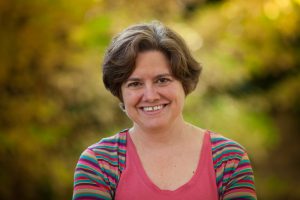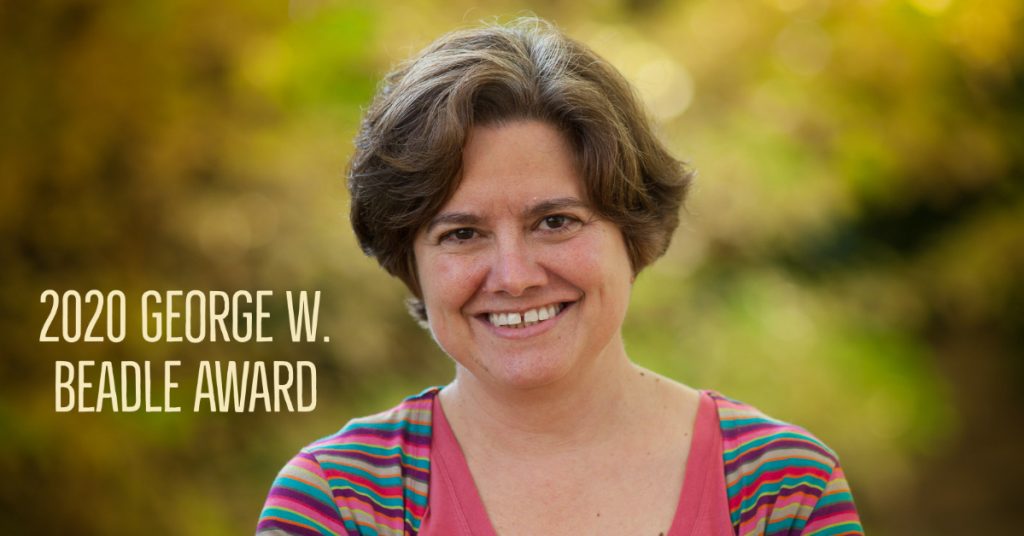 Julie Ahringer has focused her career on understanding development and transcriptional regulation in Caenorhabditis elegans. Along the way her lab has built invaluable tools, including a genome-wide RNAi library, that have supported a huge range of discoveries across biology. In recognition of this work, Ahringer has been awarded the 2020 George W. Beadle Award from the Genetics Society of America for individuals who make outstanding contributions to the community of genetics researchers.
Julie Ahringer has focused her career on understanding development and transcriptional regulation in Caenorhabditis elegans. Along the way her lab has built invaluable tools, including a genome-wide RNAi library, that have supported a huge range of discoveries across biology. In recognition of this work, Ahringer has been awarded the 2020 George W. Beadle Award from the Genetics Society of America for individuals who make outstanding contributions to the community of genetics researchers.
“Ahringer has distinguished herself in the areas of transcriptional regulation and genome architecture by posing insightful questions and producing groundbreaking publications,” says Judith Kimble of the University of Wisconsin-Madison, Ahringer’s PhD advisor and one of the researchers who nominated her for the award. “Her community contributions have focused on C. elegans research, but her impact reaches far beyond.”
Ahringer originally thought she’d become an engineer, but after two years of coursework at Lafayette College, she was struggling to choose an undergraduate major. To take her mind off the decision, she read a magazine article about Barbara McClintock and her discovery of DNA transposition, and she immediately decided to turn her problem-solving skills toward making new biological discoveries. Ahringer majored in chemistry, pursued a PhD in biochemistry, and has never looked back.
Her engineer-like approach to detail and methods have served her well in genetics. She started working on C. elegans with Kimble at the University of Wisconsin. “It’s a beautiful and simple animal, having just 1000 somatic cells. It grows from an egg to an adult in three days and is transparent, so you can watch it develop. It’s a great system for studying nearly any aspect of biology.” she says.
As a postdoc she moved to the MRC Laboratory for Molecular Biology in Cambridge UK, where she studied embryogenesis by making 4D videos of C. elegans mutants using techniques developed in her advisor John White’s group. Working on a mutant of a heterotrimeric G-protein developed by Ronald Plasterk, she helped to uncover the role of the protein in spindle orientation. Her independent lab at the Gurdon Institute launched with studies of spindle orientation and cell polarity and has evolved to focus on chromatin and gene expression in worms.
The C. elegans RNAi feeding library developed out of the Ahringer lab’s search for genes involved in early embryo development and cell polarity. The original plan was to use RNAi to silence thousands of genes by injection in pools and then assess phenotypes of embryonic lethals using 4D videorecordings. “Then postdoc Andrew Fraser had the idea: ‘What if we could make an RNAi library, with a feeding clone for every gene?” The idea seemed a bit crazy and would need money, but Ahringer wrote a letter to the Wellcome Trust and within a week received a supplementary award of £70,000 to support the work. A three-person team set to work on protocols to make the library. After nine months, at the end of 1999, all procedures worked, and they churned out Chromosome I within a month, Ahringer recalls. “Initially, we thought this was mainly for our lab.” But then her group presented the work at conferences in 2000 and were mobbed with library requests. To finish the library, PhD student Ravi Kamath organized the work, and all eight lab members pitched in to make 16,757 RNAi clones.
“Her vision accelerated a stunning swath of C. elegans research. This accomplishment is simple to state but has had (and continues to have) huge impact on the community,” says Paul Sternberg of Caltech, who also nominated Ahringer for the award. “What’s been really rewarding is seeing all the great science that’s been done with the library and across every kind of biology,” Ahringer says.
More recently Ahringer’s group has focused on chromatin and gene expression regulation in C. elegans. They started working on genome-wide mapping of different types of chromatin and where different proteins are binding. They then needed to figure out exactly where promoters were located. This wasn’t yet known because in worms, unlike many other organisms, messenger RNAs are trans-spliced, meaning that promoter locations can’t be inferred from the beginning of the mRNA sequence. That led to painstaking work to identify 45,000 regulatory elements and annotate them. “That is essential because you can’t study transcription if you don’t know where the promoters and enhancers are,” says Ahringer. With those tools they have been studying tissue-specific activities, and they’re now studying how the genome is regulated on a cell-by-cell basis through specific developmental trajectories to understand how cell-type specific gene expression is achieved.
But as with the RNAi library, these datasets are supporting research outside Ahringer’s laboratory. “Her datasets defining regulatory elements, mapping histone modifications, and chromatin binding proteins have become crucial community resources,” Kimble adds. Ahringer has also produced software including BEADS to normalize ChIP-seq data and SeqPlots to visualize diverse genomic data. “Together, these contributions have provided critical tools and key datasets used worldwide,” Kimble says.
In addition to her problem-solving mindset, Ahringer says that watching the work on the worm and human genomes develop when she was a postdoc inspired her to pursue ambitious questions. Conversations at the pub on Friday evenings with John Sulston and other colleagues tossed around interesting ideas and how they might be achieved. “You can do anything if you can work out how to do it: You work out a procedure; you develop your methods; you apply them; and you can do it.” she says.
The George W. Beadle Award honors individuals who have made outstanding contributions to the community of genetics researchers. Ahringer will accept the award at TAGC 2020 Online.
The next nomination period will open in September 2020.













